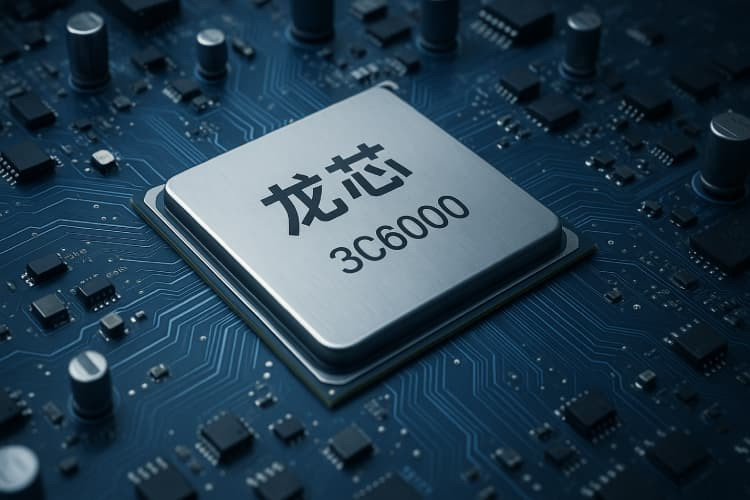China Semiconductor Industry Pushes With 3C6000 Chips
Insights | 28-08-2025 | By Robin Mitchell

Key Things to Know:
- Western export controls backfired, accelerating China’s domestic semiconductor innovation and investment.
- Loongson’s 3C6000 CPUs showcase ISA independence with up to 64 cores, competitive performance, and national security certification.
- China’s self-reliant chip strategy is reshaping global supply chains and challenging Western tech dominance.
- Engineers and policymakers face new dilemmas balancing cost, security, and innovation in adopting Chinese technologies.
China’s semiconductor industry is entering a new phase of rapid development, reshaping global supply chains and challenging long-standing technology dependencies. Western export controls were intended to slow this progress, but they’ve instead driven significant investment into domestic chip design, manufacturing, and innovation.
How have these restrictions accelerated China’s push for self-reliance, what role do Loongson’s new 3C6000 CPUs play in this shift, and what could these developments mean for engineers, manufacturers, and policymakers worldwide?
China’s Ongoing Semiconductor Self-Reliance
Not long ago, Western nations woke up to a perceived threat: China’s rapid technological rise. Their response? Slam the brakes hard by imposing serious restrictions on China’s access to cutting-edge semiconductor technology. The goal was straightforward: slow China down before it could overtake the West and block it from weaponising that technology economically or militarily.
At first glance, this strategy seemed to work. Western governments and companies tightened export controls, cutting off China’s supply of advanced chips and critical equipment. It was a classic containment play: deny access, stall progress, maintain dominance.
But, like many attempts to curb ambition, this one backfired. Instead of crippling China’s tech ambitions, it lit a fire under them. Forced into a corner, China doubled down on developing its own semiconductor ecosystem. Rather than relying on Western imports, Chinese firms and government programs poured resources into home-grown chip design, fabrication, and innovation.
Fast forward a few years, and the picture looks very different. China’s semiconductor industry is no longer just catching up, it’s advancing rapidly, with domestic chips powering everything from smartphones to electric vehicles (EVs). Speaking of EVs, Chinese automakers are now rolling out electric cars that not only rival Western models but in some cases outperform them.
Ironically, the West’s attempt to stifle China’s tech progress has arguably strengthened it. China is now in a stronger, more independent position than before the sanctions were imposed. The very restrictions meant to keep China dependent and contained ended up accelerating its path to technological sovereignty.
This is a classic example of a strategic miscalculation. The West took a path intended to slow China’s rise but ended up paving the road for China to confidently cruise down on its own terms.
China Advances Chip Independence with Loongson 3C6000 CPUs
Loongson Technology has officially launched its 3C6000 series CPUs, marking a major step toward China’s tech self-sufficiency. These general-purpose processors use Loongson’s own instruction set architecture, LoongArch™, designed to replace foreign ISAs like x86 and ARM and reduce reliance on external licensing and supply chains.
To anchor timelines for readers: the 3C6000 line was publicly unveiled in Beijing on June 26, 2025, with production systems slated through domestic OEMs over the following quarters. The series emphasises ISA independence — LoongArch™ removes exposure to foreign licensing — and targets government, telecoms, finance, and industrial control workloads where supply-chain sovereignty is paramount.
Specs and performance at a glance
- Core variants: single-chiplet “S” (up to 16 cores), dual-chiplet “D” (up to 32 cores), and quad-chiplet “Q” (up to 64 cores), with scalable mesh interconnect (LoongLink).
- Process & IO: manufactured on a mature ~12 nm node; multi-channel DDR4 memory controller; PCIe 4.0 lanes; on-chip crypto and security modules.
- Benchmarks: integer throughput in line with mainstream 2023 server parts. Independent comparisons place single-package parts around Xeon Silver 4314 class, with multi-chiplet models competitive against higher-tier Xeon Gold/Platinum in selected workloads.
- Security: the platform has passed national “Secure & Reliable” testing with a Level-2 rating in China, indicating suitability for mission-critical deployments.
Performance tests show the 3C6000 matches mainstream global processors from 2023, with third-party benchmarks comparing it to Intel’s 3rd Gen Xeon Scalable CPUs. Zhang Xiaorong of Beijing’s Cutting-Edge Technology Research Institute called this a breakthrough that breaks foreign tech monopolies and enhances national security.
Loongson also unveiled the 2K3000 and 3B6000M chips targeting industrial control and mobile computing, demonstrating a broadening product lineup. Chairman Hu Weiwu stated that the company has “systematically mastered the core technologies” spanning AI, graphics, and foundational software, signalling a new innovation era with next-gen CPUs underway.
The LoongArch ISA is central to China’s strategy for tech independence. Ministry official Shi Huikang noted the rapid growth of LoongArch-based products and the qualitative improvement of domestic tech ecosystems now that China controls its processor architecture.
These CPUs passed rigorous security tests by the China Information Technology Security Evaluation Center, earning Level 2 certification, the highest level for mission-critical environments. Some enterprises have already deployed them in core systems.
Hu emphasised the 3C6000 as a platform for industry collaboration, aiming to build a self-reliant software and hardware ecosystem based on LoongArch. Early ecosystem signals include dozens of domestic server and motherboard partners announcing pilot systems, with government and state-owned enterprise rollouts prioritized.
How Will Chinese Products Affect The West?
China’s march toward tech self-reliance is no longer just a geopolitical headline; it’s a real, tangible force reshaping markets and supply chains worldwide. This shift raises serious questions for Western engineers, businesses, and policymakers alike.
For decades, China was primarily a commodities and manufacturing hub, producing practical but often unremarkable products. Now, Chinese firms are pushing technological boundaries, from processor designs like Loongson’s LoongArch CPUs to advanced microcontrollers and power silicon. These aren’t just copies; many Chinese products are gaining a reputation for quality and, in some cases, superiority.
Now this creates a serious dilemma, as without trade restrictions, it’s tempting, and financially smart, for Western engineers to integrate these solutions. The cost savings alone can be significant, especially for startups and cost-sensitive sectors. After all, why pay a premium when a cheaper, sometimes better alternative exists?
Governments might try to clamp down on Chinese imports, citing national security or economic concerns. But history tells us such restrictions only work to a point. They often invite higher prices from domestic providers, who then have less incentive to innovate or lower costs, which is exactly the problem driving engineers toward Chinese alternatives in the first place.
Security concerns are valid and can’t be ignored. However, for many applications, especially non-critical or consumer-facing ones, the risks may be overstated or manageable with proper safeguards.
So where does that leave us?
Should Western industries ban Chinese tech outright, risking higher costs, supply chain disruptions, and potentially stifling innovation? Or should they pragmatically embrace these products, using market demand as leverage to push Western manufacturers to compete on price, quality, and transparency?
In reality, it’s unlikely to be black and white. A nuanced approach balancing security, economics, and innovation will be necessary. But one thing’s clear: China’s rise as a tech producer is reshaping the global landscape, and Western stakeholders need to adapt, not just react.

